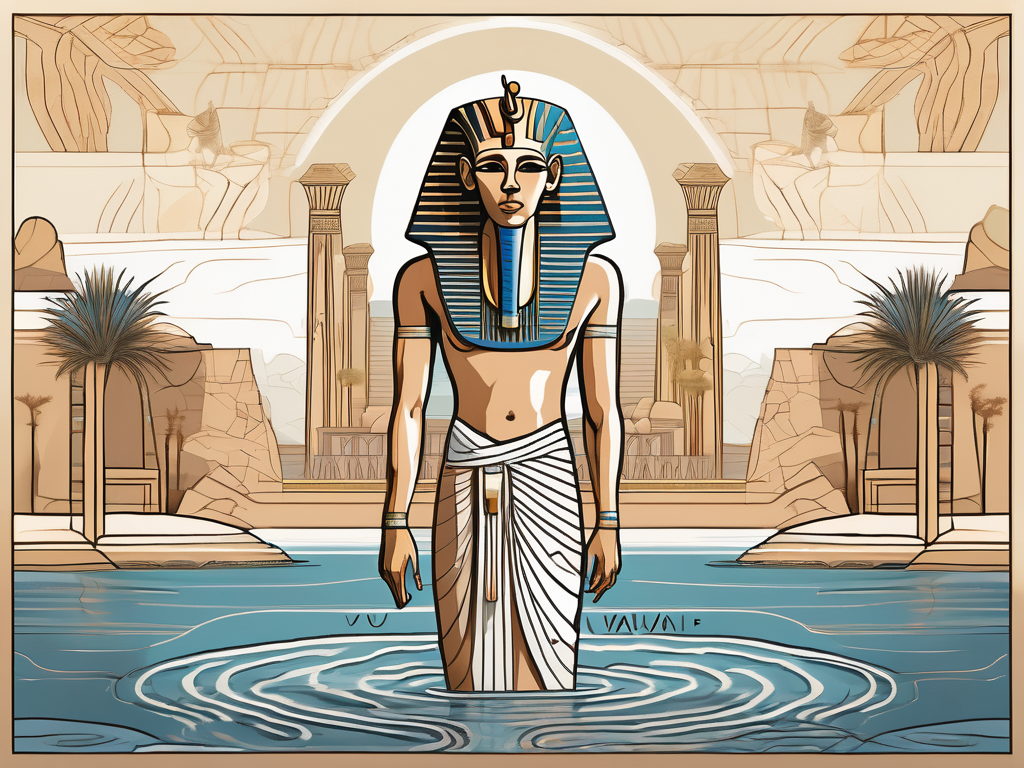Are you ready to embark on a journey filled with mystery and wonder? Join us as we dive into the depths of history and unveil the ancient tomb of the revered Egyptian god, Osiris. This remarkable discovery has shed new light on the rich tapestry of Egyptian mythology and offers invaluable insights into the enigmatic world of the Pharaohs.
The Historical Significance of Osiris in Egyptian Mythology
Before we delve into the details of the tomb, let’s first understand the role Osiris played in Egyptian mythology. Osiris, also known as the God of the Afterlife, was a key figure in the ancient Egyptian pantheon. He symbolized resurrection, fertility, and the cycle of life and death. The story of Osiris and his eternal battle against evil captivated the hearts and minds of the Egyptians, shaping their beliefs and rituals.
Understanding the Role of Osiris
In Egyptian mythology, Osiris was believed to be the ruler of the underworld, guiding souls into the afterlife. His role was central to the religious practices of the ancient Egyptians and his worship permeated every aspect of their society. From rituals performed during the flooding of the Nile to the intricate burial rites, Osiris played a pivotal role in ensuring the passage of the deceased to the realm of the gods.
Osiris was not only associated with the afterlife but also with fertility and the cycle of life and death. He was often depicted as a mummified figure, symbolizing the resurrection and renewal of life. The Egyptians believed that Osiris’s death and subsequent resurrection represented the eternal cycle of the seasons, with his death symbolizing the barrenness of winter and his resurrection representing the rebirth and fertility of spring.
Furthermore, Osiris was seen as a just and wise ruler, embodying the ideals of kingship. He was often depicted wearing the Atef crown, a tall white crown adorned with ostrich feathers, which symbolized his authority and divine power. The Egyptians believed that their pharaohs were the earthly embodiment of Osiris, ensuring the continuity of life and order in the mortal realm.
Osiris in Ancient Egyptian Art and Literature
The enduring legacy of Osiris can be seen in the magnificent artworks and literary masterpieces of ancient Egypt. Throughout the centuries, artists and writers sought to capture the essence of this mythical figure, immortalizing him in stone carvings and vivid hieroglyphics. These works of art served as a visual representation of the Egyptians’ spiritual connection to the divine and their unwavering belief in the afterlife.
One of the most famous depictions of Osiris is the “Osiris Myth,” a complex narrative that tells the story of his murder by his brother Set, his resurrection by his wife Isis, and his subsequent ascension to the throne of the underworld. This myth was not only a popular subject in ancient Egyptian art but also a source of inspiration for countless religious rituals and ceremonies.
In addition to visual art, Osiris’s story was also immortalized in ancient Egyptian literature. The “Book of the Dead,” a collection of spells and prayers intended to guide the deceased through the afterlife, often featured references to Osiris. These texts provided a roadmap for the deceased to follow in order to reach Osiris’s realm and attain eternal life.
Overall, Osiris’s significance in Egyptian mythology cannot be overstated. His role as the God of the Afterlife, his association with fertility and the cycle of life and death, and his portrayal in art and literature all contributed to shaping the religious beliefs and practices of the ancient Egyptians. The story of Osiris continues to fascinate and inspire people to this day, reminding us of the enduring power of myth and the human quest for immortality.
The Discovery of the Tomb
Fast forward to our modern era, where a team of intrepid archaeologists made a groundbreaking discovery – the long-lost tomb of Osiris. This remarkable find sent shockwaves through the archaeological community and ignited a frenzy of excitement and intrigue.
As news of the discovery spread, scholars and enthusiasts from around the world flocked to the site, eager to witness history in the making. The tomb, shrouded in an air of mystery and anticipation, held the promise of unlocking ancient secrets and shedding light on a civilization long forgotten.
The Initial Findings
Upon entering the tomb, the team was greeted by a sight that exceeded all expectations. Intricately carved reliefs adorned the walls, depicting scenes from Osiris’ mythical battles and his triumphant journey into the afterlife. The level of craftsmanship and attention to detail was awe-inspiring, a testament to the skill and artistry of the ancient Egyptians.
As the archaeologists meticulously examined the reliefs, they discovered hidden symbols and hieroglyphics, each with its own story to tell. These intricate carvings provided a window into the religious beliefs and rituals of the time, offering a glimpse into the lives of the people who once worshipped Osiris.
Further exploration of the tomb revealed a series of chambers, each holding its own treasures and mysteries. In one chamber, a collection of ornate sarcophagi lay in perfect alignment, their intricate designs hinting at the status and importance of those buried within. In another chamber, a cache of ancient artifacts, including jewelry, pottery, and ceremonial objects, offered a glimpse into the daily lives and cultural practices of the ancient Egyptians.
Archaeological Techniques Used in the Excavation
The excavation of the tomb required a delicate balance of meticulous planning and cutting-edge archaeological techniques. The team employed state-of-the-art scanning technology to create detailed 3D digital models of the tomb’s interior. Through these virtual reconstructions, we were able to explore every nook and cranny, unraveling the mysteries hidden within.
Using ground-penetrating radar, the archaeologists were able to map out the layout of the tomb, identifying hidden chambers and passageways that had been concealed for centuries. This non-invasive technique allowed them to preserve the integrity of the site while still uncovering its secrets.
Once the layout was established, the team carefully removed layers of debris and sediment, revealing the pristine condition of the tomb’s interior. With delicate brushes and tools, they meticulously cleaned and documented each artifact, ensuring that no detail was overlooked.
As the excavation progressed, the archaeologists faced numerous challenges, from unstable structures to fragile artifacts. However, their expertise and dedication allowed them to overcome these obstacles, piecing together the story of Osiris and his significance in ancient Egyptian mythology.
Decoding the Hieroglyphics and Artifacts
One of the most captivating aspects of this extraordinary discovery is the opportunity to decode the hieroglyphics and unravel the stories hidden within the artifacts found within the tomb.
The Language of the Ancients: Hieroglyphics
Hieroglyphics, the ancient Egyptian writing system, provided a key to unlocking the secrets of the tomb. Through painstakingly deciphering the intricate symbols and characters, experts uncovered a wealth of knowledge, shedding light on the rituals, beliefs, and daily lives of the ancient Egyptians.
The Significance of Artifacts Found in the Tomb
From exquisite jewelry to finely crafted statues, the artifacts discovered within the tomb offered invaluable insights into the craftsmanship and artistic talents of the ancient Egyptians. These treasures reflected the deep reverence and devotion the Egyptians held for Osiris, showcasing the lengths they went to honor their beloved god.
The Architecture of the Tomb
Beyond its historical significance, the architecture of the tomb itself is a marvel to behold.
Design and Layout of the Tomb
The meticulous design and layout of the tomb reveal the Egyptians’ unwavering commitment to ensuring a safe passage for their beloved deity. Intricate passageways and chambers were constructed with precision, taking into account the celestial alignments and sacred geometry revered by the ancient Egyptians.
Symbolism in the Tomb’s Architecture
Every detail within the tomb was imbued with symbolism, reflecting the Egyptians’ profound understanding of the spiritual realm. From the colors used in the murals to the orientation of the chambers, each element carried a deeper meaning, inviting us to explore the intricate web of beliefs woven by this enigmatic civilization.
The Impact of the Discovery on Modern Egyptology
The unearthing of Osiris’ tomb has not only provided a glimpse into the past but has also had a profound impact on modern Egyptology.
New Insights into Ancient Egyptian Religion
By unraveling the mysteries contained within the tomb, scholars have gained invaluable insights into the complex belief system of the ancient Egyptians. This newfound knowledge has deepened our understanding of their rituals, religious practices, and the intricate web of gods and goddesses that governed their lives.
Implications for Future Archaeological Explorations
The discovery of Osiris’ tomb has paved the way for future archaeological explorations, igniting a renewed sense of curiosity and a desire to uncover more hidden wonders. With cutting-edge technology at our disposal, we stand on the cusp of unraveling even more mysteries, breathing life back into the long-forgotten stories of our ancestors.
As we conclude our journey through the tomb of Osiris, we can’t help but marvel at the intricate web of mythology, artistry, and spirituality woven by the ancient Egyptians. This remarkable discovery serves as a testament to the enduring legacy of Osiris and his profound impact on the lives of the Egyptians. May it inspire future generations to delve deeper into the mysteries of the past and continue unraveling the secrets of this extraordinary civilization.












